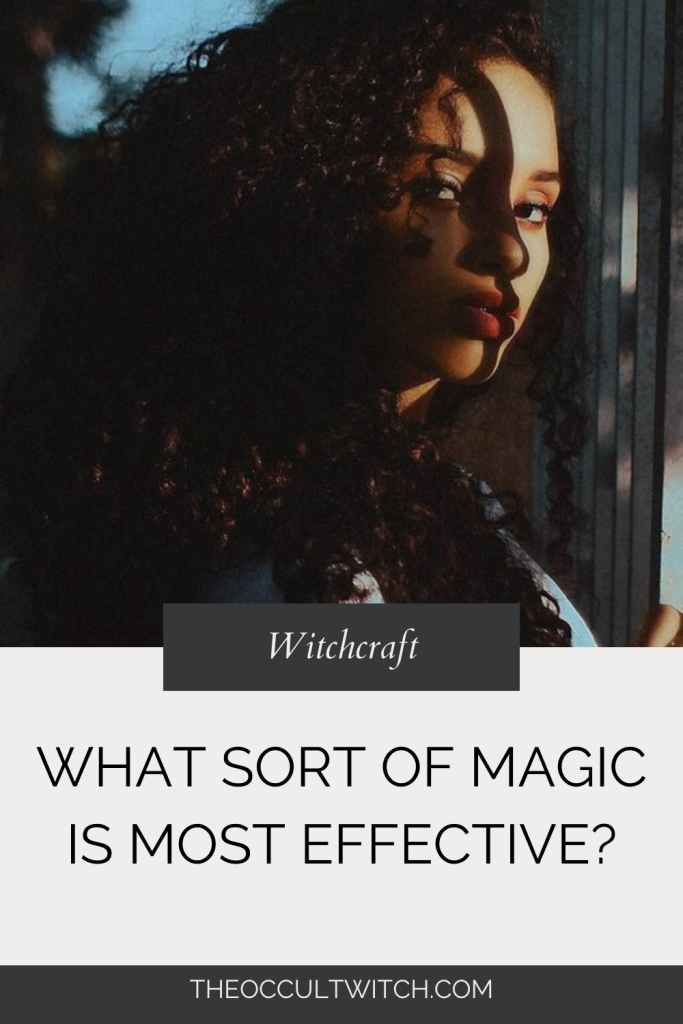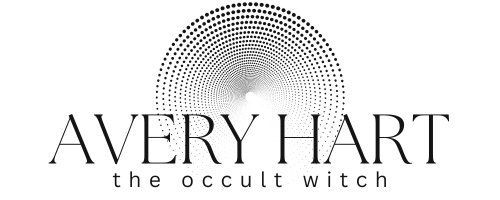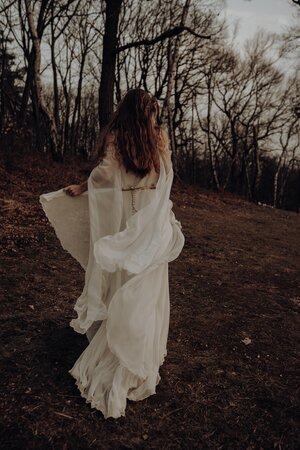If I ask you what the right way to do witchcraft is, would you have an answer? And if you have an answer, do you think the next person I ask would give the same answer as you? Chances are, they would not. It doesn’t take much to see that witchcraft and magical communities are often very split on what the “right” way to do magic is.

This can be really confusing for beginner magicians and new witches who are trying to decipher what the most effective form of magic is for them. How are you supposed to know who has the correct information and who doesn’t? How are you supposed to sift through the thousands of magical traditions and ways of working that exist and are easily accessible today? I mean, before the modern age if you wanted to learn magic you simply learned whatever magic was available to you. You learned what was regionally practiced and what you had access to based on your community, your socioeconomic status, and your personal ties to other magical practitioners.
In many cases, this meant you only had one option! By contrast, today we have an entire planet’s worth of magical practices at our fingertips. The internet, while amazing for ease of access to information, does present a bit of a conundrum when we are faced with the overabundance of choice in what to believe and what to practice. The learning process for magic has gone from difficult to find and very limited to a truly overwhelming amount of choices.
So then, how do we parse through the unfathomable number of choices and options that we have available today to become effective witches? Is there a correct way to practice magic? If we choose the wrong methods are we simply going to be short-changing ourselves and stunting our growth as magical practitioners? In today’s post, we’re going to be exploring these questions and the magical theory behind this incredible diversity in the craft. We will be taking a look at how we choose the magical practices that will work best for us and what role tradition plays in our craft.
Diversity In Magical Practices
Anyone who has ever tried to research witchcraft or magic on the internet knows that there are about a million different ways to do magic out there and many of them are very contradictory. I don’t need to tell you how confusing it can be to try to create a personal practice out of the insane quantity of magic books, TikTok videos, and blog posts that we have available to us today.
At a very high level, we can split magic into a few categories. We have ceremonial magick and folk magic as two broad categories that we split ourselves into. We have regional practices like Hoodoo, Appalachian folk magic, Santeria, Italian Stregheria, and so many more. There are carefully crafted traditions such as Wicca, Feri, and many of the occult orders. There are the foundational building blocks of magic such as candle magic and spirit work. And there are the looser practices that find their way into many traditions and methods of magic such as tarot and astrology.
As someone new to the practice of magic, this incredible diversity can be staggering. Often one of the first things people ask me is “How do I know what’s real and what’s fake?” It can be so overwhelming being confronted with this incredible amount of information that people are left unsure of how to tell the difference between magic that works and magic that doesn’t. Nobody wants to devote hours of study and practice to a kind of magic that will never produce results. And that is what we’re all here for! We want magic that produces results and creates actual change in our lives. Anything else is simply an exercise in fooling yourself into feeling good.
Without results, there is no magic.
So how do we explain this crazy diversity in magical practices? Is there actually a tradition that works better or is more “real” than others? Is natural magick better? What about sorcery? Or chaos magick? Does sigil magick work better than herbal magick?
The simple answer is no. The reason there are so many magical practices is that there are a wide variety of methods that actually work! Pretty much every well-established tradition of witchcraft or magic works.
How Can So Many Paths Be True?
If you’re currently wondering how so many contradictory traditions can all be right, it’s okay. It can seem unfathomable that one tradition says that blowing out candles negates your magic while another says that blowing out candles helps to send your energy out into the world to do its work and that both traditions are right. How can it be possible that two directly conflicting traditions are both right?
As witches, we often have to stretch ourselves beyond the limits of what common knowledge says is true. Common knowledge says that magic doesn’t exist. Common knowledge says that if we can’t measure it, it isn’t real. Common knowledge says that if two conflicting ideas exist, one of them must be wrong. In witchcraft, however, many things that seem contradictory can be true simultaneously. One of the main reasons for this is that these seemingly contradictory practices are unified under a common magical theory. That is, there is a higher law of magical functioning that allows both contradictory viewpoints to exist and be true at the same time.
To get a better understanding of this, we need to dig into our magical theory. What causes a magical action to have an effect? There are several ways that a magical effect can be created. As in the case of blowing out a candle, the effect is created by the intention or symbolic association held by the magical practitioner. In other words, whether blowing out the candle enhances your magic or negates it is simply a matter of what the magical practitioner believes will happen as a result of that action. This is a very cut and dry instance of “form follows thought”, also known as the law of attraction in new age circles. This theory of magic states that our thoughts and beliefs are what direct energy and that this movement of energy is what creates the reality that we live in. By consciously utilizing our thoughts and beliefs in a ritualized manner, we are able to change the reality that we live in.
This means that for many traditions of magic, the beliefs held within that tradition are what create the effect of the magic. This is certainly not the only thing driving our magic but this is on of the reasons why contradictory practices can all be effective and still create results despite believing entirely different things. The belief in the method is what creates the result.
There are also traditions that rely on other theories of magic. For example, Hoodoo works heavily with spirits and animism. In Hoodoo, the magical effects are created through a relationship with the spiritual essence of places, roots, and entities. These relationships can be highly individual and as a result, you can find Hoodoo practitioners that disagree on practices within their own communities. Does the fact that two separate Hoodoo practitioners disagree mean that one of them is right and one of them is wrong? No. It simply means that these practitioners hold different beliefs and have different relationships with the spirits that they work with. Both practitioners can be perfectly effective within their modality of magic.
What Even Is Tradition?
This brings us around to the idea of tradition and what is traditional within the craft. It’s not hard to find conversations between magicians about who has the more traditional method of working. The real problem of these kinds of conversations is that “traditional” means something different depending on who you ask. What one person might consider “traditional” witchcraft could in fact be a form of magic that was historically practiced in Britain. What another person considers traditional witchcraft might be something that was historically practiced on the West coast of the United States. Neither of these people are wrong, they are simply talking about different traditions!
What is considered traditional is dependent upon individual perspective. What I might consider traditional could be based on where I grew up, my nationality or ethnicity, or the nationality or ethnicity of my ancestors, the form of magic practiced by those who came before me, the age of the magical practice, etc. For example, I grew up in the deep south of the US and learned a system of magic that is very similar to Hoodoo. Because of this, I could consider Hoodoo and other deep south forms of magic traditional. By contrast, my family is heavily German so I might consider Germanic and Norse forms of magic to be traditional. Or I could choose to join an organized magical group with a traceable history such as Feri witchcraft, and I could consider that traditional. Or I could eschew tradition altogether and follow in the footsteps of chaos magicians who focus on results above all else, tradition be damned.
This is the true downfall of trying to craft a “traditional” form of magic for yourself. Unless you are very careful about how you define what traditional means to you, you will be finding yourself pulled in about a hundred directions every time you try to have a conversation about traditional witchcraft. What is traditional to a witch in Ireland is entirely different from what is traditional to a witch in New England or a witch in Mexico. Tradition is no guarantee of effective magic or more “valid” magical practices. It is simply a word that denotes some form of historical basis within a practice.
What Does This Mean For Your Craft?
So what does this mean for you in your practice? How do you pick through everything that exists out there that you could possibly use to create your own craft to find what works for you?
The first thing to take away from all of this is that it doesn’t really matter which tradition or which method of magic you choose, there is a very high likelihood that it will be effective if it is a practice that suits you well.
This is probably the most important thing to consider. How well does a system of magic suit you personally?
I know that I am not a ceremonial magician. My magic is not rigid, highly ritualized, or particularly grand in its presentation. I fall far more comfortably under the purview of folk magic. I prefer magic that is far more informal and fluid in its practice. I prefer to work with spirits and animistic principles in a sort of conversation rather than from a commanding role. This knowledge of my magic and preferences helps me to narrow down my practice significantly as it allows me to ignore ceremonial magic as a whole for anything outside of academic interest.
These preferences are not innate inborn qualities that we have. They’re not something you just know about yourself before you’ve ever had a chance to experiment. I didn’t know I wasn’t a ceremonial magician until I tried it a few times and the whole endeavor felt stiff, like I was faking it. Even with years of experience in magic, ceremonial magic will never feel as natural as more flexible forms of magickal practice. These are things you learn through trial and error and through getting to know yourself in this new magical context. This means that you have a license to experiment a bit! Do you know whether you prefer ceremonial magic or folk magic? If not, you might try finding simple practices from each form of magic to try for yourself and see how each one feels and what kind of results you get.
Another great way to narrow down what you should be focusing on is simply to follow your interests. This is something that a lot of teachers forget to mention. We can get so caught up telling people what they should learn and when they should learn it and what order they should learn it in that we forget that not everybody is going to have the same goals and interests. What is wildly successful for one witch may feel like a complete dead end for another.
The best way to guide yourself through this confusing learning phase is simply to follow your interests. What is it that you find most intriguing about witchcraft or magic? Are you fascinated by sigils? Does magic theory make your toes curl? Do you love the idea of long drawn out rituals with robes and complex circles drawn in chalk on the floor? Do you want to work with spirits? Do you love plants? What is it that really catches your interest about magic?
A great place to start exploring this is at your local library, go to your libraries magic section and just grab whatever catches your eye. This allows you to check out plenty of resources and even if you don’t get the absolute best book on a topic, it give you a great start for not a lot of money. We want to go for breadth, not depth and you want to not just read but actually try some of what you’re reading about. See how it feels and then watch for results. Sometimes you won’t feel a lot but you may get incredible results. That’s still effective magic!
This is the reality of how just about everyone learns magic. We develop an interest and we follow that interest. We learn and grow and we try things and we see what gets us results and then we learn and grow some more. In truth, witchcraft is not a collection of traditions and set ways of doing magic. Witchcraft is a million individual ways of doing magic. Every single practitioner is essentially their own branch of magic. No two witches do things exactly the same.
This is the real strength of witchcraft. As witches, we are the experts in our individual magical practice. We are the priests and priestesses of our own spirituality. Witchcraft is a method of taking back power for ourselves. It is a way of finding our own truths and our own power without relying on a higher order to hand it to us. There are many things we can learn from the elders and experts that have come before us, but this does not mean that they hold every single answer. Witchcraft is an ever-evolving practice that responds to the lived experiences of those who seek it out. There is no single right way to do witchcraft or single correct branch of witchcraft because witchcraft is always changing and growing and improving.
If you want to know what kind of magic or witchcraft you should practice then what you need to ask yourself is what do you need out of your magic? And what interests you about magic? When you answer these two questions, you can point yourself in a solid direction and start learning. Don’t let the fear of “fake magic” stop you. If it works for you, then use it. If it doesn’t work for you, then don’t. Focus always on what gets you real results and what allows you to make tangible changes in your life. That is what witchcraft is for.
Struggling with your magic?
Take the Quiz to Discover Your #1 Witchcraft Obstacle

Updated on November 14, 2024 by Avery Hart



